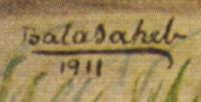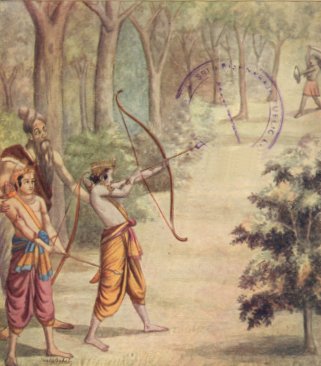Chitra Ramayan
First Published: July 24, 2005 in Amma's Column
Page Last Updated: December 07, 2024
Last week (July 14, 2005) I stumbled on a Ramratan (jewel named Ramayana).
My friend Dr. Rajeshwari Chatterjee (83), who is shortly leaving for U.S.A., to join her daughter, son-in-law and their two sons on a short holiday, told me that she has a very old illustrated volume of Ramayana, which she enjoyed reading as a kid, along with her cousins. Without delay, I went to her place and got much more than I expected.
Chitra Ramayana (Illustrated Ramayana) is a simplified story of the great Indian epic in Kannada. The type is bold and beautiful. The thick pages have become brittle and need careful handling. Printed by B. Miller, Superintendent, British India, Press, Mazgaon, Bombay. It was published by, Shrimat Balasaheb Pandit Pant Pratinidhi, chief of Aundh, at Aundh, Satara district. The Kannada version is by Ramachandra Madhwa Mahishi
The date shown is 1916. It is all the more important because the book contains illustrations painted by the publisher also called Bhavan Rao Shrinivas Rao, the ruler of the state of Aundh himself.

The illustrated manuscript features hand-drawn pictures by the ruler himself.
As is well known, Indian subcontinent had five hundred and odd princely states under British paramountcy before independence. Aundh was a very small state in present day Maharashtra. Late Siddavanahalli Krishna Sharma, distinguished freedom fighter, Kannada writer and educationist, who toured the entire princely states of Bombay Presidency in British India, has left a vivid description of Aundh and its illustrious ruler. He visited Aundh in 1939-40.
At that time Aundh state comprised of four talukas. It was a jagir given to Parashuram Pant in 1700 AD by queen Tarabai, wife of Rajaram Bosle, brother of Shivaji Maharaj. The title Pant Pratinidhi was accorded by her. Bhavan Rao Balasaheb became ruler in 1905. At the time Mr. Sharma met him, he was past seventy but strong and steady. He was fond of Suryanamaskar (Indian aerobics exercise which involved exercise of all limbs at the same time) and made physical culture a compulsory subject in school. He built a museum at his own expense which housed rare artifacts of which Sharma has left a good description. Balasaheb had personally collected many of the pieces including one sculpture by Gertrud Hems and another by Henry Moore. He purchased a 2,600 year old Greek idol from British Museum. There were artifacts from all states of India and many Asian countries.
kamat.com/Kamat's Potpourri
Rama Killing Demon Tataka
Teacher Vishwamitra asks his student Rama to get rid of Takata
Painting was Rajasaheb's hobby. He used to draw and paint as a kid. His letter written when he was seven year old to his father, camping at Pune contained a request to bring him a picture. This letter .is preserved in museum. A complex of big museum cum art-gallery and art-school was coming up to house the huge collection of sculptures, paintings, old manuscript, icons, miniature paintings, rare books and other curios which Rajasaheb had collected over years. He himself had painted innumerable sequences from Ramayana and Mahabharata which were on display.
This present book, an old edition of Ramayana perhaps, originally contained, 70 paintings based on various anecdotes and events connected with Rama. Balasaheb painted them - to bring out the message of Ramayana better. This dilapidated volume now contains only 37 of the paintings. Other loosely pasted paintings are torn or fallen off. Unfortunately, every surviving painting has the stamp of Nanjangud Public library. Some Ancestors of Dr. Rajeshwari might have borrowed or acquired the book, which later came into safer hands! Kamat Potpourri gratefully acknowledges, Dr Rajeshwari's willingness to use the pictures of the great Art lover, Balasaheb Pandit Pant Pratinidhi who published this Chitra Ramayana and liberally provided illustrations to make the story of Rama highly interesting.
![]()
